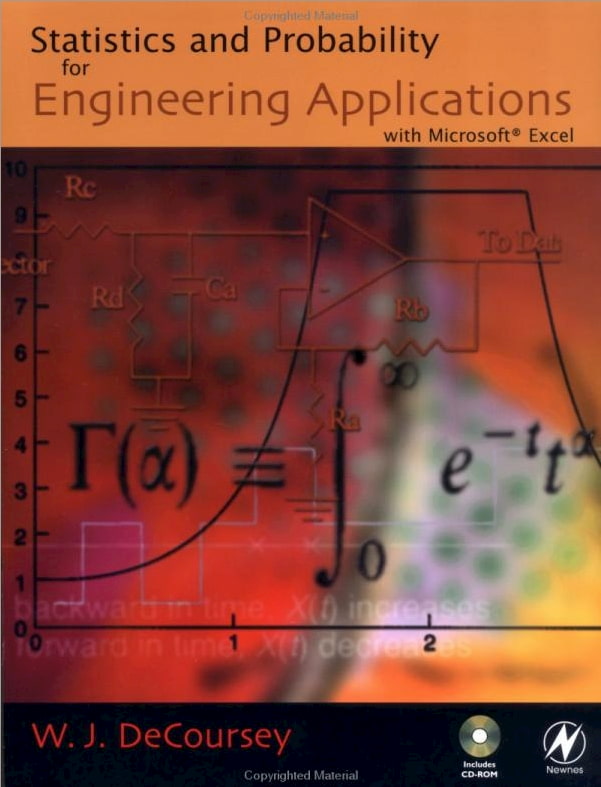This book has been written to satisfy the requirements of two different groups of readers. On one hand, it’s suitable for practicing engineers in industry who need a far better understanding or a practical review of probability and statistics. On the other hand, this book is eminently valuable as a textbook on statistics and probability for computer engineering students.
Areas of practical knowledge supported the basics of probability and statistics are developed employing a logical and understandable approach which appeals to the reader’s experience and former knowledge instead of to rigorous mathematical development. The sole prerequisites for this book are an honest knowledge of algebra and a first course in calculus.
The book includes many solved problems showing applications altogether branches of engineering, and therefore the reader should pay close attention to them in each section. The book are often used profitably either for personal study or in a class.
Writer of “Probability and Statistics for Engineering Application with Microsoft Excel“ is W.J. DeCoursey.
Probability and Statistics for Engineering Application with Microsoft Excel: Table of Content
Preface
What’s on the CD-ROM?
List of Symbols
1. Introduction: Probability and Statistics
1.1 Some Important Terms
1.2 What does this book contain?
2. Basic Probability
2.1 Fundamental Concepts
2.2 Basic Rules of Combining Probabilities
2.2.1 Addition Rule
2.2.2 Multiplication Rule
2.3 Permutations and Combinations
2.4 More Complex Problems: Bayes’ Rule
3. Descriptive Statistics: Summary Numbers
3.1 Central Location
3.2 Variability or Spread of the Data
3.3 Quartiles, Deciles, Percentiles, and Quantiles
3.4 Using a Computer to Calculate Summary Numbers
4. Grouped Frequencies and Graphical Descriptions
4.1 Stem-and-Leaf Displays
4.2 Box Plots
4.3 Frequency Graphs of Discrete Data
4.4 Continuous Data: Grouped Frequency
4.5 Use of Computers
5. Probability Distributions of Discrete Variables
5.1 Probability Functions and Distribution Functions
(a) Probability Functions
(b) Cumulative Distribution Functions
5.2 Expectation and Variance
(a) Expectation of a Random Variable
(b) Variance of a Discrete Random Variable
(c) More Complex Problems
5.3 Binomial Distribution
(a) Illustration of the Binomial Distribution
(b) Generalization of Results
(c) Application of the Binomial Distribution
(d) Shape of the Binomial Distribution
(e) Expected Mean and Standard Deviation
(f) Use of Computers
(g) Relation of Proportion to the Binomial Distribution
(h) Nested Binomial Distributions
(i) Extension: Multinomial Distributions
5.4 Poisson Distribution
(a) Calculation of Poisson Probabilities
(b) Mean and Variance for the Poisson Distribution
(c) Approximation to the Binomial Distribution
(d) Use of Computers
5.5 Extension: Other Discrete Distributions
5.6 Relation Between Probability Distributions and Frequency Distributions
(b) Fitting a Binomial Distribution
(c) Fitting a Poisson Distribution
6. Probability Distributions of Continuous Variables
6.1 Probability from the Probability Density Function
6.2 Expected Value and Variance
6.3 Extension: Useful Continuous Distributions
6.4 Extension: Reliability
7. The Normal Distribution
7.1 Characteristics
7.2 Probability from the Probability Density Function
7.3 Using Tables for the Normal Distribution
7.4 Using the Computer
7.5 Fitting the Normal Distribution to Frequency Data
7.6 Normal Approximation to a Binomial Distribution
8. Sampling and Combination of Variables
8.1 Sampling
8.2 Linear Combination of Independent Variables
8.3 Variance of Sample Means
9. Statistical Inferences for the Mean
9.1.1 Test of Hypothesis
9.1.2 Confidence Interval
9.2.1 Confidence Interval Using the t-distribution
9.2.3 Comparison of Sample Means Using Unpaired Samples
9.2.4 Comparison of Paired Samples
10. Statistical Inferences for Variance and Proportion
10.1 Inferences for Variance
10.1.2 Comparing Two Sample Variances
10.2 Inferences for Proportion
10.2.1 Proportion and the Binomial Distribution
10.2.2 Test of Hypothesis for Proportion
10.2.3 Confidence Interval for Proportion
10.2.4 Extension
11. Introduction to Design of Experiments
11.1 Experimentation vs. Use of Routine Operating Data
11.2 Scale of Experimentation
11.3 One-factor-at-a-time vs. Factorial Design
11.4 Replication
11.5 Bias Due to Interfering Factors
(a) Some Examples of Interfering Factors
(b) Preventing Bias by Randomization
(c) Obtaining Random Numbers Using Excel
(d) Preventing Bias by Blocking
11.6 Fractional Factorial Designs
12. Introduction to Analysis of Variance
12.1 One-way Analysis of Variance
12.2 Two-way Analysis of Variance
12.3 Analysis of Randomized Block Design
12.4 Concluding Remarks
13. Chi-squared Test for Frequency Distributions
13.1 Calculation of the Chi-squared Function
13.2 Case of Equal Probabilities
13.3 Goodness of Fit
13.4 Contingency Tables
14. Regression and Correlation
14.1 Simple Linear Regression
14.2 Assumptions and Graphical Checks
14.3 Statistical Inferences
14.4 Other Forms with Single Input or Regressor
14.5 Correlation
14.6 Extension: Introduction to Multiple Linear Regression
15. Sources of Further Information
15.1 Useful Reference Books
15.2 List of Selected References
Appendices
Appendix A: Tables
Appendix B: Some Properties of Excel Useful
Appendix C: Functions Useful Once the
During the Learning Process
Fundamentals Are Understood
Appendix D: Answers to Some of the Problems
Engineering Problem-Solver Index
Index
Conclusion
If you really enjoyed “Probability and Statistics for Engineering Application with Microsoft Excel“, I’d be very thankful if you’d help it spread by emailing it to a friend, or sharing it on Twitter or Facebook and pin post images on your Pinterest. Thank you very much!
Did you read “Probability and Statistics for Engineering Application with Microsoft Excel” on the way? Which one you are reading—and how it is similar to one of this?
- What do you think about Probability and Statistics for Engineering Application with Microsoft Excel?
Leave a comment below to tell us about your feed back!
Related Topics: If you enjoy this book, then there are some more interesting books are given below for you!
Our Android Apps
The Google Play store contains over 3 million apps; some are masterpieces. Our team is also participating in making android projects. If you really enjoy this article, “Basic Engineering Mathematics – 5th Edition” then you should also try some of our educational android apps and support us by giving us rating in Google Play Store, if you love these apps.



































